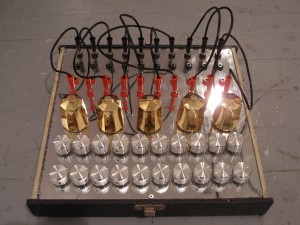The Motor City area has a new hackerspace!!! i3 Detroit held their grand opening this past Saturday 10/3 much to the delight of the geeks of the midwest. They even lured in the mayor of Royal Oak to perform the ribbon cutting. As was fitting, the i3 folks set up a “ribbon” of amphenol cable and gave the mayor an acetylene cutting torch to do the honors.
Though unforch I was out of town for the opening, I was able to get out to i3 a few weeks back to meet a few of the i3 founding members. Led by Russ Wolfe, i3 is filled with super friendly folks overflowing with ideas, talent, and enthusiasm. To boot, their space is DOPE!! Tis ground level with a garage door, electronics lab, classroom, reading loft, and…they’ve got metalworking equipment!!! Oh, dear angle grinder and MIG welder, how I love your sparks, smoke, noise…and how I hope see you join with microcontrollers and heavy duty servos to make robots that fix abandoned buildings! How I would love to see a homebrew alt fuel open source automobile roll out the i3 doors! Pipe dreams?? Only time will tell…
